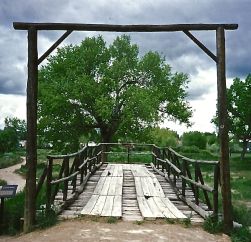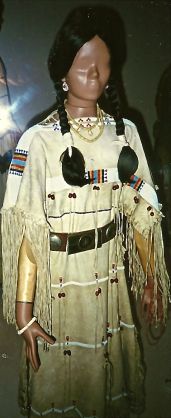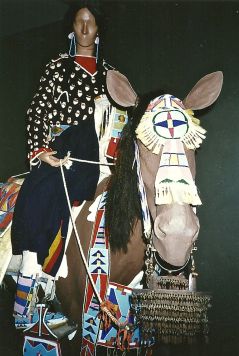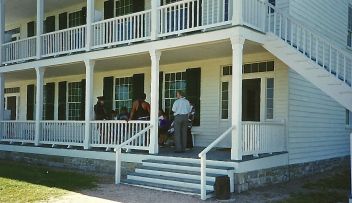TWO FOR ONE: How My Research Trip to Wyoming for
SO WIDE THE SKY inspired COLOR OF THE WIND.
My husband and I flew into Cody, Wyoming the first week in June. There was snow on the ground when we landed; by the end of the week it was ninety degrees. Which was probably a fitting introduction to this beautiful and rugged land.

Inspired by this photograph of Olive Oatman, (See previous blog.) I read everything I could get my hands on about Olive’s capture by Indians and her return to her own people. By the time I finished my research, I’d decided the story I wanted to tell was best served by using a fictional heroine. That meant more research. This time I focused on relations between the Plains Indians and the whites between 1851, when Olive was taken, to the Battle of Little Bighorn in June of 1876.
The time and location that seemed best suited to my story was the year 1866 at Fort Casper, Wyoming Territory. This was where a bridge crossed the Platte River connecting the road from Fort Laramie in southern Wyoming to where Fort Phil Kearney was being hastily constructed in the north to protect the Bozeman Trail, which led north to the gold country in Montana and connected with the Oregon Trail.
Since the Fort Laramie Treaty of 1851 had ceded much of the area north of the Platte to the Cheyenne and Sioux, that made the gold miners, the soldiers and the settlers intruders.
Our first research stop in Cody was at the Buffalo Bill Historical Center <centerof thewest.org> where I spent two days focusing on the life and art of the west.
Most of my time was spent with the artifacts from the Plains Indians. The pieces these people made and used in their daily lives—the Cheyenne war shirts and weapons, the men’s beaded pipe bags and paraphernalia, the women’s high-pommeled saddles, their deerskin dresses beautifully beaded and shivering with fringe and the brightly patterned parfleches where they stored their belongings—speak as much of their lives as their artistry. The museum complex proved to be a good introduction to the natural history of Wyoming, the cowboy life, Buffalo Bill’s Wild West Show and the artists who immortalized the natural beauty and life in the west.
We drove east from Cody to Casper to see the partial reconstruction of the 1860’s fort. It was a drive that helped us better understand the lay of the land in Wyoming. Watctching “the deer and the antelope playing” on the planes delighted us.
These are some of the photographs of the barracks and stables at Fort Casper. (Referred to in SO WIDE THE SKY as Fort Carr in the book.) Since no officers’ housing had been reconstructed at Fort Casper, I based my descriptions in the novel on other forts of the period.
This is a drawing of the area in about 1866.
We also spent a day exploring the area around the fort. That included the Red Butes area, about four miles north and west of the 1867 bridge. This was where Cassie and Drew and Drew’s daughter Meggie have their winter picnic, and where
Cassie rescues her stepdaughter when she falls through the ice. We also hiked around Caspar Mountain, which makes a cameo appearance later in the novel.
Driving south, we visited Fort Laramie. This is the headquarters building, known at an earlier period when it was the bachelor officers’ quarters, as Old Bedlam.
East of the fort, we visited a place where wheel ruts had been cut deep into the rocks. This happened when the pioneers on the Oregon Trail “locked” their wheels with chains and “skied” their wagons down the rise and into the Platt Valley.
Before we left Wyoming, I was eager to revisit the Big Horn Mountains. When my college roommate and I drove cross-country, the Big Horns were the first “real mountains” we flatlanders had ever seen. We stopped at EVERY overlook to take pictures and gape, completely awed by the mountain’s majesty. The Big Horns proved to be every bit as magnificent on my second visit.
Somewhere on our ramble through the mountains and back to Cody, we stopped in a rustic town for lunch. In the bookstore up the street, I discovered some fascinating nonfiction books about the cattle ranches that flourished along the face of the Big Horns in the 1880’s. What surprised me was that for a time English investors owned many the ranches in this part of Wyoming.
What intrigued me more was that this was where the aristocracy would exile their n’er do well younger sons when they had disgraced the family. Most of these “remittance men” reformed and went back to England to lead productive lives—but some of them stayed to prosper and build ranches of their own. What was it about this wild and beautiful place that drove them turn their backs on Europe and stay?
That was the question that inspired COLOR OF THE WIND and brought one determined spinster, three orphaned children and a remittance man together.
But then, that’s a story for another day.











Just finished the third book. Loved the series. And after reading your post, had to share how we had been out in Wyoming last summer with our grandson and even went to the buffalo bill museum. Now I would like to go back and revisit!
We loved Wyoming when we were there researching SO WIDE THE SKY, and it’s obvious you liked it, too.
I had driven through with a girlfriend on summer vacation when we were both young teachers, and the beauty of those rugged vistas really inspired me. The passage we made through the Big Horn Mountains is what led me to do the research on the remittance men and the British holdings in cattle ranches that sprung up at the base of the mountains in the 1880’s. Teddy Roosevelt’s memoir of the years he spent on the frontier following his first wife’s death was a great read! Well written and full off great information.
Thank you so-o-o much for your cant-put-down wonderful novels! Thanks for your travels and treks. Benn thru Wyoming on the California Zehpher train and hope to take one of your novels aboard the empire Builder train to see ” big sky country” Montana this fall.
Have ordered 3 more of your novels for tablet. Keep em coming!
Sincerely
Virginia Jordan, African American retired First-Grade teacher
Oh, Virginia —
How I envy you your travels across the country by train. That part of the country both intrigues and inspires me.
I explained above a little about why MOON IN THE WATER has taken so long, but I am working diligently to make this as strong and compelling a story as it can possibly be.
I taught elementary art for a good many years, and I know that First-Grade teachers work really hard to try and give their children an enthusiasm for learning that will last through their whole of their academic career — and long into adulthood as well. It’s a very special calling.